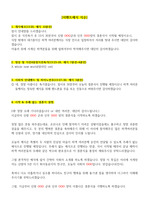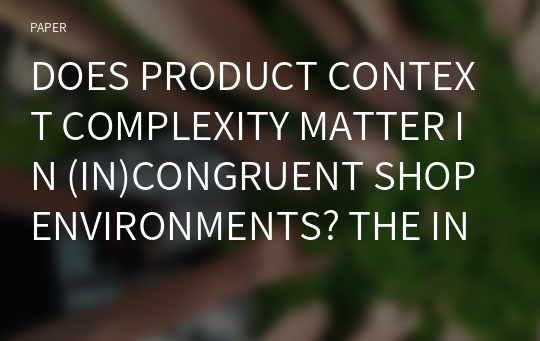DOES PRODUCT CONTEXT COMPLEXITY MATTER IN (IN)CONGRUENT SHOP ENVIRONMENTS? THE INFLUENCE OF PROCESSING FLUENCY ON PRODUCT EVALUATION
* 본 문서는 배포용으로 복사 및 편집이 불가합니다.
서지정보
ㆍ발행기관 : 글로벌지식마케팅경영학회(GFMC)
ㆍ수록지정보 : GFMC Session1
ㆍ저자명 : Manuela Valta, Donata Vianelli
ㆍ저자명 : Manuela Valta, Donata Vianelli
영어 초록
Consumers process and evaluate products every day in an increasing number of diverse presentations of products and brands across shop environments. Although consumers may think to react to attributes of the products and the shop environments, there are many contextual factors that influence consumers’ responses. Both products presentation and shop environments differ in visual complexity and ease of processing. For example, products such as fragrances and eyeglasses considerably diverge depending on the visual presentation across multiple stores. Research on processing fluency (e.g., Reber et al., 2004; Winkelman et al., 2003) shows that the processing of any stimulus can be characterized by a variety of parameters that are nonspecific to its content. This stream of work suggests that any variable that facilitates fluent processing results in increased liking, and other positive evaluations. Recent work on context complexity (Orth and Crouch, 2014) suggests that people process a package more fluently when it is presented in a low rather than high complexity context. Further, research on contextual cues (Zhu and Meyers-Levy, 2009) shows that the extent of feature overlap between a context and a target object determines whether a person interprets the target related or not related to the contextual data. Accumulating research suggests that a deeper understanding of the way consumers process multiple contextual cues promises to shed light on our understanding of many areas of consumer research. Although visual appeal is itself multifaceted (Bloch, 1995), much of the current discussion with respect to visual cues does not consider the interaction of multiple shop environments. Given the importance of processing fluency and context effects, we examine the extent to which consumers positively elaborate cognitive processes in relation to product context complexity. Following research in psychology, fluency is the subjective experience of ease with which a person processes a stimulus (Reber et al. 2004). High fluency elicits a positive reaction. We predict that less complex contexts of the product will be easier to process and produce more favorable evaluations of the product. Further, research on contextual cues (Aggarwal and McGill, 2007; Meyers-Levy and Sternthal, 1993) shows that consumers better overlap contextual cues when cues are moderately congruent rather than low congruent. This suggests that consumers respond more favourably to moderate congruent shop environments. Studies Two studies tested our prediction that product context complexity across shop environments affects consumer’s processing fluency, liking, and product evaluation. In both studies, participants were provided with pictures of real products and shop environments. Images were manipulated to disguise brand names. Participants were recruited online through the platform Prolific Academic. Study 1 tested the hypothesized negative effect of product context complexity on processing fluency, and liking. The final section of the survey asked for personal information, including gender, age, and style of reasoning. These variables had no significant impact on the dependent variables of interest and were excluded from further analysis. In study 1, ninety participants (mean age = 34.20, 63 females) were randomly assigned to one of the two conditions (product context complexity: low vs. high). They viewed one randomly selected picture of cosmetics displayed on counter displays across two different stores. Cosmetics was chosen due to the large variance in products presentation across multiple retailers. In a pretest, 87 participants rated perceived complexity of the display to examine whether the display complexity differs across the two conditions. The manipulation was successful (Mlow = 2.32 vs. Mhigh = 3.68; F(1,85) =24.299, p < 0.001). Running one-way ANOVA with product context complexity as independent variable and processing fluency as dependent variable a significant main effect of the context complexity (M = 5.05 vs. M = 4.37; F (1,87) = 3.913, p < 0.05). To test our prediction that liking is mediated by processing fluency of product context complexity, a mediation analysis was conducted (PROCESS model 4: Hayes, 2014). Bootstrap estimation confirmed that processing fluency mediates the influence of product context complexity on liking (simple slope = 0.44, LLCI = 0.01, ULCI = 0.94). In study 2, our aim was to corroborate and extend study 1 findings by testing product context complexity in congruent and less congruent shop environments. One hundred seventy-seven participants (mean age = 35,31, 80 females) viewed one randomly selected combination of chocolate shop environments. As in study 1, we chose chocolate due to the large variance in products presentation across multiple retailers. Chocolate was displayed on tower displays (products context complexity: low vs. high), and matched with the overall in-store presentation of three chocolate shop environments (shop environment congruence: low vs. moderate vs. high). After processing the pictures, participants were asked to rate processing fluency, liking, and product evaluation. Similarly to Study 1, the final section of the survey asked for personal information, including gender, age, and shopping goal. Again, these variables had no significant impact on the dependent variables of interest and were excluded from further analysis. Two pretests confirmed that our manipulation of product context complexity (Mlow = 1.96 vs. Mhigh = 4.01, F(1,57) = 23.464, p < 0.001) and store processing fluency (Mlow = 3.50 vs. Mmoderate = 4.14 vs. Mhigh = 5.10, F(1,109) = 10.465, p < 0.005) were successful. Running a factorial ANOVA with processing fluency as dependent variable indicated a nonsignificant main effect of product context complexity. Shop environment congruence had a significant main effect (F(2,171) = 6.561, p < 0.005). Contrasts analysis revealed significant differences between the high congruence/context complexity condition and the low congruence/context complexity condition, and between the moderate congruence/context complexity condition and the low congruence/context complexity condition (all ps < 0.005). We then tested the prediction that processing fluency mediates the effects of shop environment congruence on liking and product evaluation through product context complexity as moderator. We used a moderated mediation analysis with the bootstrap PROCESS model 8: Hayes, 2014). There was a significant conditional indirect effect of shop environment congruence on liking though product context complexity in the high context complexity condition, b = -0.280, LLCI = -0.509, ULCI = -0.120. A similar estimation with product evaluation as the independent variable revealed that processing fluency mediated the relationship between significant shop environment congruence and product evaluation though product context complexity in the high context complexity condition, b = -0.375, LLCI = -0.631, ULCI = -0.153). Discussion Our findings demonstrated the influence of product context complexity on processing fluency and product evaluation. The results showed that less context complexity leads to an ease of processing. Study 1 confirmed the negative relationship between product context complexity and processing fluency. Further, study 1 demonstrates a mediation mechanism of processing fluency on liking. This result confirms prior work on processing fluency (Reber et al., 2004). Further. we extend previous work on visual complexity (Orth and Crouch 2014) by demonstrating that low congruence shop environments may influence consumer processing fluency. In study 2, we looked at how consumers respond to complex and less complex presentation of products in congruent and less congruent shop environments. Our results support research on contextual cues (Zhu and Meyers-Levy, 2009) by showing an interesting path of complex contextual cues. Complex contexts may affect consumer’s evaluation of products. This pattern is more pronounced in low congruent shop environments. Consumers may evaluate much less favorably visually complex contexts in low congruence shop environments than in congruent shop environment. Such behavior is due to the extent to which consumers overlap the shop environment and the target product. This research shed light on how consumers combine retail and product cues. By integrating research on processing fluency and contextual cues, our work allows a better crafting product design and retail strategies. Apart from the theoretical contributions, this research provides marketing manager with insights into how to develop easier to process shop environment for consumers. The results suggest that when products are presented with complex contexts, consumers respond less favorably to the visual appearance of their products. For retail managers, the results provide insight into why it might be especially difficult to process more complex settings of the products. The results suggest that to make a shop environment more favorable, managers have to find solutions to reallocate complex contextual cues of the products. This could be done through developing more congruent areas within the store. Given the growing importance of visual strategies in retailing, our research gives managers suitable solutions to allocate in-store resources.참고 자료
없음"GFMC Session1"의 다른 논문
 FAST AND SLOW FASHION BRANDS IN DEVELOPING SUSTAINABLE ..6페이지
FAST AND SLOW FASHION BRANDS IN DEVELOPING SUSTAINABLE ..6페이지 “WHAT IF A CELEBRITY AND A BRAND CO-CREATE A NEW COLLEC..7페이지
“WHAT IF A CELEBRITY AND A BRAND CO-CREATE A NEW COLLEC..7페이지 THE INSTAGRAM’S STRATEGY IN ENGAGING THE CUSTOMER’S LOY..3페이지
THE INSTAGRAM’S STRATEGY IN ENGAGING THE CUSTOMER’S LOY..3페이지 THE PARTICULARITIES OF NEW PRODUCT DEVELOPMENT IN THE T..5페이지
THE PARTICULARITIES OF NEW PRODUCT DEVELOPMENT IN THE T..5페이지 THE LONE CHOCOLATE BAR: THE INFLUENCE OF PERCEIVED SCAR..6페이지
THE LONE CHOCOLATE BAR: THE INFLUENCE OF PERCEIVED SCAR..6페이지 ADS AS WORKS OF ART: MEASURING ADVERTISING IMMERSION3페이지
ADS AS WORKS OF ART: MEASURING ADVERTISING IMMERSION3페이지 ECONOMIES OF SMALL: NICHE STRATEGIES AND SUCCESS FACTOR..8페이지
ECONOMIES OF SMALL: NICHE STRATEGIES AND SUCCESS FACTOR..8페이지 THE INFLUENCE OF ONLINE CUSTOMER REVIEWS ON RETAILERS' ..6페이지
THE INFLUENCE OF ONLINE CUSTOMER REVIEWS ON RETAILERS' ..6페이지 IS THE ARTIFICATION PROCESS PERCEIVED BY FINAL CONSUMER..6페이지
IS THE ARTIFICATION PROCESS PERCEIVED BY FINAL CONSUMER..6페이지 THE ODD EVEN PRICE PARADOX IN THE FASHION LUXURY SECTOR6페이지
THE ODD EVEN PRICE PARADOX IN THE FASHION LUXURY SECTOR6페이지





















